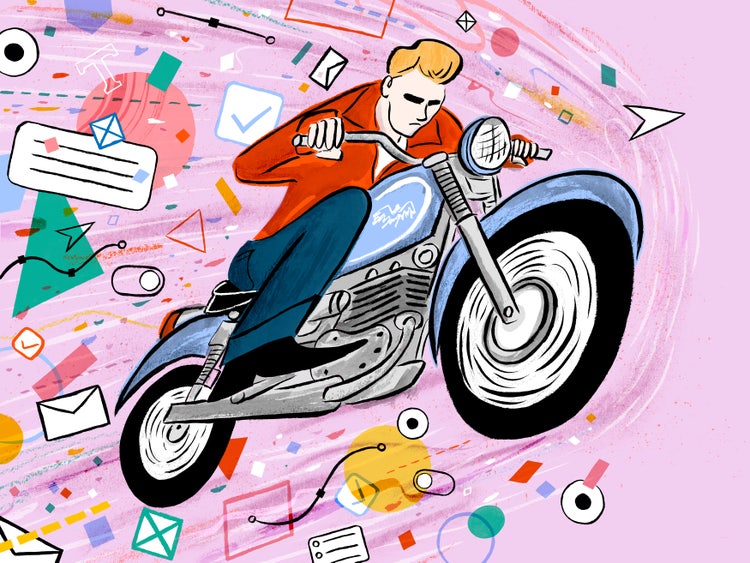The design rebel checklist
Interview questions to uncover work experience that really matters

Illustration by Daniel Gray-Barnett
The checklist is based on my experience interviewing, being interviewed, participating in interview panels, hiring, and working alongside successful designers and leaders—then synthesizing what they had in common, what made them stick around and also be worth keeping around, and what made them unique.
This is a different checklist or script than you will get from your talent partner or read about in hiring manuals—it’s a rebel checklist.
My own beginnings in design were very humble. Together with two friends I started a digital agency in Switzerland. It was the golden days of the Internet… just before the first bubble burst. I was head of design for a team of one: myself. We needed to grow. The discipline of experience design didn’t really exist yet. We were all self-trained. Nobody knew what to write in a job description or what exactly to hire for. We were young and inexperienced. And it showed. My first hire was a disaster and we eventually had to let that person go. I felt terrible. It was brutal. I decided then that I hated management. I wasn’t ready.
Much has changed since then. I’ve grown to love the people management aspect of being a design leader, because I figured out what it takes to build powerful design teams. And I learned it by hiring the right interns, new college grads, designers, senior designers, and design managers from different countries, cultures, and backgrounds.
A divergent interview script
Great designers are creative rebels. But most companies, for obvious reasons, are unlikely to have a process in place that promotes any type of rebellion.
The interview process at most companies is fairly rigid. It follows a certain structure, trying to cover a fixed set of criteria. This is well intended, but I have to confess that I’ve ignored it more often than not. (Please forgive me, my former talent partners.) Instead I developed my very own interview script to tease out what I’m most curious about, to get at those experiences that really matter, and to find my rebels.
Here are the first five questions from that script. Use them in your next interview:
1. What detours have you taken on your path?
The most successful and impactful people on my teams didn’t come here on a straight career path. They had non-traditional design careers or educations. They were architects, fashion designers, photographers, accountants, engineers—even a physicist. On those winding paths they accumulated unique experiences that led them to become associative thinking superheroes with superpowers for creative problem solving. You want to learn about the parts of their path that had nothing to do with design.
2. What don’t you know?
Be more curious about what a candidate wants to learn in their new role versus what they already know how to do. The bigger their hunger and opportunity to learn, the better their chances to feel fulfilled in their role, and the better the chances they’ll stick around for a while. Curiosity fuels passion, and it’s passion we need. Getting an interview question answered with a simple “I don’t know” is rare these days. Cherish it! A job description usually includes a requirement along the lines of “two to three years of domain experience,” because it accelerates onboarding and suggests instant expertise. You should look for the opposite. Look for the beginner’s mind—shoshin, as it is called in Zen Buddhism. An unbiased approach to problem solving is a fascinating thing to witness, and it often leads to the most stunning results.
3. How do you not fit in?
A classic interview goal is to determine team/culture fit. Too often that translates to hiring what’s easy or familiar. Instead explore how someone doesn’t fit in. How can they impact team dynamics, challenge the people around them, create a healthy tension, and help the team and the work evolve? That’s what you need a new hire to infuse into your team.
4. What would you rather be doing right now?
As a creative professional it’s important to step away from the nine-to-five noise. It’s crucial to find and create moments of contemplation. In my case, these moments are when I’m riding my bike, practicing meditation, venturing out into nature, or seeing the world through the lens of my camera. You need to make sure that the person you hire knows how to step away... to something that’s not work, or that they deeply care about, or nothing at all. This is also a good opportunity to let them know that you support them in making space for whatever that is.
5. What can I learn from you?
Someone smarter than me once told me to hire people who are smarter or more talented than I am. So no matter how senior or junior the role you’re hiring for, look for what a person can bring to it that the company, the team, and you can learn from. Quite often this will have absolutely nothing to do with design but it allows everyone, including you, to be both student and teacher.
If you’re an interviewer and some of this resonates with you, give it a try. If you’re an interviewee, I hope it helps you see your own winding path, possible lack of domain experience, or misfit tendencies, as strengths rather than weaknesses.
Either way, best of luck to you.
This is as good a place as any to thank those smarter and more talented than me, who allowed me to learn from (and with) them along my leadership journey. Thank you!
This article originally appeared on Medium.